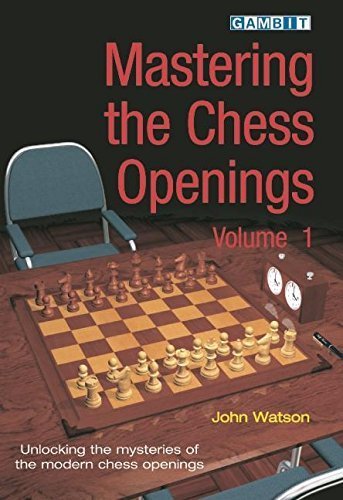For many chess-players, opening study is sheer hard work. It is difficult to know what is important and what is not, and when specific knowledge is vital, or when a more general understanding is sufficient. Tragically often, once the opening is over, a player won’t know what plan to follow, or even understand why his pieces are on the squares on which they sit. John Watson seeks to help chess-players achieve a more holistic and insightful view of the openings. In his previous books on chess strategy, Secrets of Modern Chess Strategy and Chess Strategy in Action, he explained vital concepts that had previously been the domain only of top-class players. Moreover, he did so in ways that have enabled them to enter the general chess consciousness of club players. Here he does likewise for the openings, explaining how flexible thinking and notions such as ‘rule-independence’ can apply to the opening.
In this major two-volume work, Watson presents a wide-ranging view of the way in which top-class players really handle the opening, rather than an idealized and simplified model.
This volume, focusing on king’s pawn openings, is a book that will make chess-players think hard about how they begin their games, while offering both entertainment and challenging material for study in openings such as the Sicilian and Ruy Lopez.
About the Author
International Master John Watson is one of the world’s most respected writers on chess. His groundbreaking four-volume work on the English firmly established his reputation in the 1980s, and he has produced a string of top-quality works since. In 1999, Secrets of Modern Chess Strategy, Watson’s first book for Gambit, won the British Chess Federation Book of the Year Award and the United States Chess Federation Fred Cramer Award for Best Book. His pupils include the 1997 World Junior Champion, Tal Shaked.
Reviews
“When your reviewer was a teenager in 1964, there were no databases, no Internet, precious few really good chess books and no DVDs. I picked up a copy of Nimzovich’s Chess Praxis and a copy of My System. Over the course of my summer vacation, I read those books. My rating jumped from 1400 to almost 1700. I actually started to understand some key chess ideas. For those of you who want a similar epiphany in the 21st century, these two volumes by Watson will do the job.” — Pete Tamburro, Chess Life
“Even though volume one mostly deals with 1 e4 and volume two deals with 1 d4, the books nonetheless represent one body of work that should best be enjoyed together, and they are written by one of the finest authors of the last several decades. … To say that these books are about opening strategies or opening theory would be a disservice to the importance of the material covered in them. … I found his chosen examples excellent and his commentary instructive and very enlightening. Whether you are an inexperienced improving player or a seasoned tournament player, you will learn loads from studying these books. His discussions of pawn structures and their interconnected strategies are worth the price of both books. Even I feel as though my game has improved after having studied both volumes at length. … The books convey an understanding of the opening that even specialized opening works do not provide. … I highly recommend the two volumes of Mastering the Chess Openings to anyone who truly wants to improve their understanding of the openings and of chess in general. — Carsten Hansen, www.chesscafe.com
“If you are aspiring to be a strong player you should really like this book. … I’ve been putting off writing about this book because there is so much in it to read it’s hard to figure out where to start. The section I started out with this morning was the Sicilian Poisoned Pawn, Fischer’s contributions, and latest theory (which by the way holds that Black has excellent winning chances, AND, so does White!). In fact, it seems that this is the currency of this book-openings where the better prepared player and student has chances of winning. … In the beginning he writes about ‘Fundamentals’ and covers 80 pages on that, structure, opening ideas and positional features, and the introduction to the Open Games. Here’s a thought – read those 80 pages if you read nothing else. You will learn a lot about chess and it will probably spur you on to looking at the later chapters. This section has been very ably written and it explains a lot of the things the rest of us take for granted, but for which we really don’t know all that well. Seriously, read this. … In fact, just get this book. Full retail is $29.95 and it’s worth every cent – it’ll teach you chess.” —Bob Long, www.chessco.com



